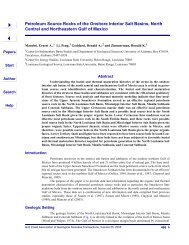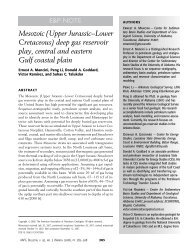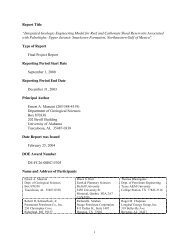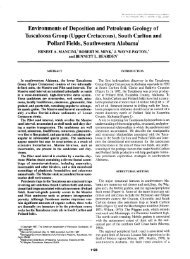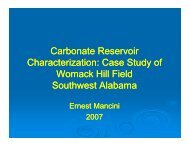Part 4 - Berg - Hughes Center
Part 4 - Berg - Hughes Center
Part 4 - Berg - Hughes Center
Create successful ePaper yourself
Turn your PDF publications into a flip-book with our unique Google optimized e-Paper software.
oundary between thick transitional crust and thin transitional crust (Corso, 1987).<br />
Although Jurassic Norphlet, Smackover and Haynesville depositional patterns are greatly<br />
affected by basement paleotopography, sediments, such as the Lower Cretaceous<br />
Knowles Limestone, reflect an infilling of the basement low areas and a general<br />
progradation of the ramp margin (Dobson, 1990). This progradation has been interpreted<br />
by Dobson (1990) to produce a change from a carbonate ramp to a rimmed platform<br />
margin. The hiatus between the Cotton Valley Group-Knowles Limestone and the<br />
Hosston Formation is represented by most of the Valanginian Stage. This unconformity<br />
and hiatus are recognized throughout the Gulf Coast (McFarlan and Menes, 1991).<br />
The Lower Cretaceous shelf margin was exposed during the early Late Cretaceous<br />
by a major lowering of sea level. This sea-level fall has been attributed to a combination<br />
of igneous activity and global sea-level fall (Salvador, 1991a). A Late Cretaceous marine<br />
transgression followed this regional erosional event, and this transgression in<br />
combination with the Laramide orogeny affected deposition from the Late Cretaceous to<br />
the Cenozoic (Salvador, 1991a). Throughout the Cenozoic, the western Gulf was the site<br />
of significant fluvial, deltaic and coastline siliciclastic sediment influx, while the eastern<br />
Gulf experienced principally carbonate deposition (Salvador, 1991a).<br />
Petroleum Systems<br />
Three active petroleum source rocks have been reported from the onshore north<br />
central and northeastern Gulf of Mexico area. The Upper Jurassic (Oxfordian) Smackover<br />
lime mudstone beds have been described as serving as source rocks in the North<br />
Louisiana Salt Basin (Sassen et al., 1987). The Upper Cretaceous (Cenomanian-<br />
Turonian) Tuscaloosa marine shale beds have been reported as serving as source rocks in<br />
436




